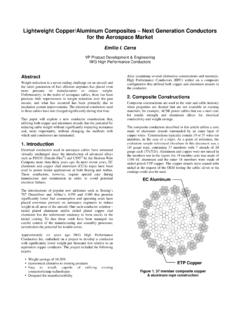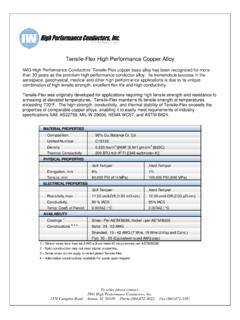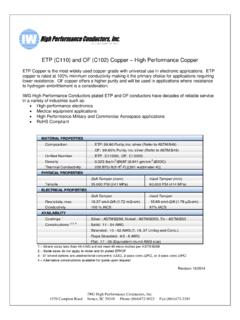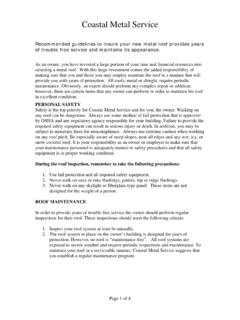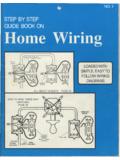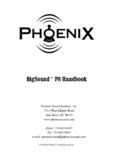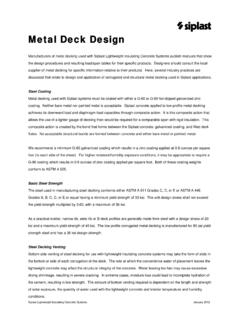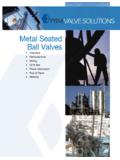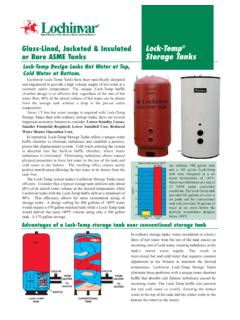Transcription of Chromium VI) Beryllium, Cadmium, Chromium VI)
1 Bare & Insulated Wire SAFETY DATA SHEETJuly 31, 2015 HEALTH FLAMMABILITY REACTIVITY protective EQUIPMENTHMIS RATINGNFPA RATING SAFETY DATA SHEET Ecological Health 0 1 0 1 0 0 SECTION 1. IDENTIFICATION Product Name: Bare and Insulated Wire; all bare and insulated wire products supplied by IWG HPC. Recommended Uses: Wiring for electrical devices. Use Restriction: None. Manufacturer/Vendor Information: IWG High Performance Conductors 1570 Campton Road Inman, South Carolina 29349 24-Hour Emergency Phone: (864) 472-0555 Other Information Phone: (864) 472-0481 FAX: (864) 472-3381 SECTION 2. HAZARDS IDENTIFICATION Chemical Classification: Metal. Signal Word: Warning.
2 Hazard Statement: Specialty bare and insulated wire is generally not considered hazardous in the form shipped or when used for its intended purpose; which is the conveyance of electrical charge. However, the installation of bare and insulated wire into products can release metallic fume and decomposed resin to the atmosphere; which may have health or safety impacts. The following statements reflect installation hazards: H302 Harmful if swallowed. H312 Harmful in contact with skin. H315 Causes skin irritation. H332 Harmful if inhaled. H335 May cause respiratory irritation. Note: Grinding, melting, welding, cutting, or any other operation(s) that reduces the particle size of the material will change the hazard classification of the product.
3 If the particle size or oxidation state of this product is reduced refer to the applicable regulatory standards for appropriate protection measures. Pictogram: Ecological, Health. Precautionary Statement: P261 Avoid breathing dust/fume/gas/mist/vapors/spray. P262 Do not get in eyes, on skin, or on clothing. P337 + P313 If eye irritation persists: Get medical advice/attention. May irritate eyes. Contact with fine particles may irritate skin. May be irritating to the nose, throat, and respiratory tract. May be irritating to the stomach. Hazards Not Otherwise Classified: Not applicable. Mixture of Ingredients with Unknown Toxicity: Not applicable. Emergency Overview: See Appendices A-1, A-2, B, and C for exposure limits to specific hazardous ingredients.
4 Under normal use there is no hazard, but thermal decomposition can release toxic vapors, gases, or fumes. Effects of Overexposure: Eye: Dust or fume may cause eye irritation. Skin Contact: Dust may cause skin irritation. Specialty bare and insulated wire is generally not considered hazardous in the form shipped. However, if your process involves grinding, melting, welding, cutting, or any other process that causes a release of dust, vapors, gas, or fumes the following adverse effects may result: Route(s) of Entry: Ingestion or inhalation and may cause skin dysfunction including discoloration. Bare & Insulated Wire SAFETY DATA SHEETJuly 31, 2015 Acute Exposure: Metal Fume Fever from welding is characterized by metallic taste in mouth; irritation of eyes, nose, throat, and skin; (flu-like symptoms) nausea, tightness of chest; loss of consciousness or even death due to welding gases or lack of oxygen.
5 Metal fume fever has been associated with metals such as zinc, magnesium, aluminum, antimony, iron, manganese, mercury, nickel and tin. However, there is insufficient evidence to conclude that exposures to copper dust and copper fume cause metal fume fever. Chronic Exposure: skin sensitization; neurological damage; respiratory disease; and kidney dysfunction. Carcinogenicity: NTP ( Chromium VI) Known Carcinogen, (Beryllium, Cadmium, Nickel) Reasonably Anticipated Carcinogen; IARC (Beryllium, Cadmium, Chromium VI) Group 1 Carcinogen; OSHA (Cadmium). SECTION 3. COMPOSITION / INFORMATION ON INGREDIENTS CAS No. Chemical Name Weight Percent (%) Conductor (see attached Appendix A-1 and A-2) Insulation (see attached Appendix B or C) SECTION 4.
6 FIRST-AID MEASURES Initial Care: Eyes: Flush eyes with plenty of water for at least 15 minutes. Skin: Wash with soap and water. Flush with large amounts of water. Use soap if available. Remove contaminated clothing, including shoes, after flushing has begun. If irritation persists seek medical attention. Ingestion: If conscious, give water. Consult a physician. Inhalation: Remove to fresh air. If not breathing, give artificial respiration. If breathing is difficult, give oxygen. Seek medical attention. Symptoms or Effects: Eyes: Irritation. Skin: Irritation. Ingestion: Irritation. Inhalation: Irritation. Immediate Medical Care and Special Treatment: Wash or irrigate as necessary. Wilson s Disease (an inherited disorder in which copper accumulates in the liver leading to copper toxicosis) may result from exposure; pre-existing dermatitis may be aggravated.
7 SECTION 5. FIRE-FIGHTING MEASURES nfpa Hazard Classification: Health Hazard: 1 Fire Hazard: 0 Reactivity: 0 Flash Pt: Not applicable Flammable Limits in Air-Lower: Not applicable Flammable Limits in Air Upper: Not applicable Auto-Ignition Temperature: Not applicable Fire Fighting Extinguishing Media: Water fog, foam, dry chemical, CO2. Fire Extinguishing equipment : As in any fire, wear approved or equivalent MSHA/NIOSH self-contained breathing apparatus pressure-demand and full protective gear. Fire Fighting Instructions: Evacuate area and fight fire from a safe distance. Fire and Explosion Hazards: Will not burn, will not explode. Unusual Hazards: Heavy airborne concentrations of fine powder in enclosed spaces may ignite or explode in the presence of sources of ignition.
8 In the presence of halogenates, copper powder may be explosive with heat, percussion, or light friction. On long standing a white deposit, which is a readily explosive peroxide, may form. In the presence of wet acetylene and ammonia, copper forms explosive acetylides. SECTION 6. ACCIDENTAL RELEASE MEASURES Fire Extinguishing equipment : As in any fire, wear approved or equivalent MSHA/NIOSH self-contained breathing apparatus pressure-demand and full protective gear. Fire Fighting Instructions: Evacuate area and fight fire from a safe distance. Fire and Explosion Hazards: Will not burn, will not explode. Unusual Hazards: Use clean-up methods that avoid dust generation (vacuum wet). Wear a NIOSH approved respirator if dust will be generated in clean up.
9 Use protective clothing if skin contact is likely. Bare & Insulated Wire SAFETY DATA SHEETJuly 31, 2015 SECTION 7. HANDLING AND STORAGE Signal Word: Warning. Handling Precautions: Not hazardous with normal use. Storage Recommendations: Do not store near acetylene, chlorine, hydrogen peroxide, or acids. SECTION 8. EXPOSURE CONTROLS / PERSONAL PROTECTION OSHA Permissible Exposure Limit: See Appendix A-2. Engineering Controls: None required in normal use. protective Devices: Eye Protection: Safety glasses with side shields. Skin Protection: Use protective clothing to prevent repeated or prolonged skin contact. Respiratory Protection: None required in normal use. If dust or vapors are created and workplace conditions warrant respirator use, a respiratory protection program that meets OSHA 29 CFR and ANSI requirements must be followed.
10 For concentrations up to 10 times the exposure limit, use NIOSH or MSHA approved half- or full-face, air-purifying respirator with appropriate particulate cartridges. For higher concentrations, consult a professional industrial hygienist. The American Conference of Governmental Industrial Hygienists (ACGIH) 8-hour time-weighted average (TWA), threshold limit value (TLV) for welding fume (total particulate) is 5 mg/m3. Ventilation: General ventilation is recommended. Local exhaust recommended if dust, mist, or fumes are being generated. Special protective Device Requirements: Not applicable. SECTION 9. PHYSICAL AND CHEMICAL PROPERTIES Appearance: Solid metals shaped as wire, strip, or ribbon with various insulation colors. Odor: N/A Odor Threshold: N/A pH: N/A Melting Point/Freezing Point: Varies depending on the type of conductor and resin coating.

